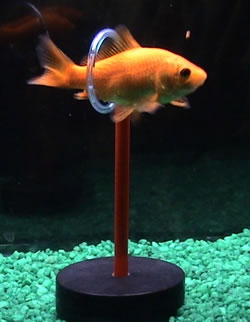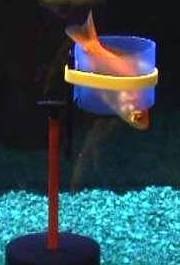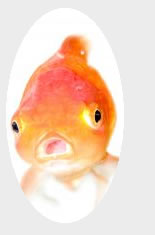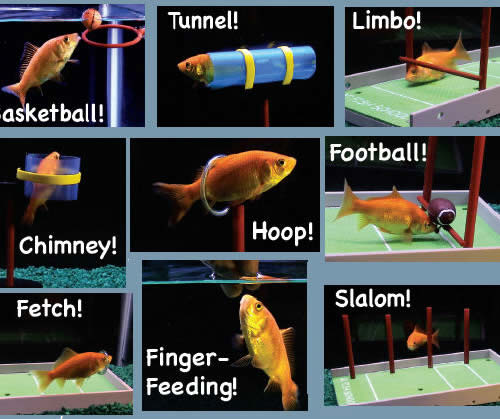Category Archives: Uncategorized
”Sex, Violence and Pee in the face – Lobster Love turns out to be a Smelly Business
A lobster dinner is often perceived as the ultimate romantic meal, but while we happily utilize their bodies to promote our own chances of passionate encounters we actually know very little about the reproductive rituals that goes on deep down in the ocean. Did you for instance know that these super romantic creatures pee each other in the face before making sweet lobster love?
“Lobsters actually pee each other in the face to communicate” says researcher Malin Skog, a Ph.D. student at the University of Lund in Sweden that will be submitting her dissertation ”Sex and Violence in Lobsters – a Smelly Business” in September. Her research is focused on the importance of fighting and peeing when lobsters mate.
“I discovered that we hardly new anything about our lobster, despite the fact that it is such an important resource for the fishing industry” Malin Skog explains when asked about her peculiar interest in crustacean copulation.
By pairing up lobsters in aquariums, Malin Skog has been able to watch and film how males and females fight each other and how an encounter sometimes results in mating, sometimes in the male getting slapped and forced to retreat. This intricate behaviour seems to be controlled through scent particles excreted in urine. On a lobster, the olfactory organ (the “nose”) is located on the smaller pair of antennae on the head and the urine is also excreted from the head. So in order to communicate through scents, lobsters actually pee each other on the head.
During a lobster fight, the winning member will excrete a scent that means “I am stronger” while the loosing combatant will secrete a scent that says “I give up”. Fighting will not only take place between males and females; lobsters readily fight members of their own sex over food, shelter and general dominance. Regardless of sex, the most violent clashes occur when two individuals of similar size battle each other. Lobster fights can easily result in lost limbs, such as legs and antennae.
When a male lobster encounters a female, the meeting will start with a fight even if the couple is ready to breed. It seems as though the male doesn’t understand that he has found a female lobster until she starts emitting the “I am a girl”-scent. When he senses this scent, he will stop fighting and start walking around her instead, touching her and trying to tip her over on her back. (Lobsters mate in the missionary position, stomach to stomach.) Sometimes the female will readily approve to being flipped over, but in other cases she will object and if she stubbornly refuses to mate no mating will occur.
Sources:
Sex and Violence in Lobsters – a Smelly Business, Malin Skog, a Ph.D. Lund university, Sweden
Interview in sydsvenskan.se (in Swedish)
Lyretail=pyrexia????????
Word spell check has made writing a lot easier but sometimes it really makes some strange suggestions. Below you see a screen shoot of a suggestion I got while writing about the Lyretail Anthias for the new marine section of this site. I really can’t understand why word though pyrexia was the word I was trying to spell.
Just go to show that you should never trust the spell check no matter how helpful it can be.
Hot koi carps
Koi carp worth almost £40,000 (=80 000USD) was stolen from a garden center in Stapleford UK. The thieves cut their way into the facility through metal fences and stole the expensive Koi carps. The thieves are believed to have know carps and the facility well as they only stole the most valuable carps living the rest. All in all they stole 30 carps. They also caused 20 000 USD damage to the garden center.
The thieves drained the holding tank on much of its water to make it easier to catch the carps. The police says it was a professional well organized heist that would have taken a lot of time to complete. They also ask for help form the public and that anyone who knows anything about this to contact them.
The owner has given the police pictures of the fish so that they can be identified and the owner is sure that the fish can be identified if found.
If you live in the UK and see expensive Koi fish for sale in the classifieds it might be worth contacting the police to see if it is these carps however seeing as it seems to have been a professional job the likely allready had a new home in mind for the fish.
Interview with Dr Dean Pomerleau
Today we have a special feature here at the AC fish news blog. An interview with Dr Dean Pomerleau who train fish to do tricks. I posted about her work about a week ago in the post “Playing basketball with your goldfish?” and he has been kind enough to answer a few questions about his work and how to train fish. I know all of you would like to start reading the interview rather than my ingress so without further ado, here is the interview.
Lets start with a little about you. What’s your background?
I have a PhD in computer science / robotics. In my “real job”, I develop collision warning system hardware and software for cars and trucks. Specifically, systems that warn the driver when he’s drifting off the road due to drowsiness, inattention or distraction.
How come you started to train fish?

So one weekend day Kyle and I were sitting around looking for something to do, and we thought “wouldn’t it be cool if we could make our pet fish more interesting by training them.”
It has just snowballed from those humble origins.
Why Goldfish?
It is what we had. We’ve also trained other fish since then, including Betta, oscars, and parrot cichlids.
Have you ever tried to train fish that is generally considered smart than goldfish such as larger cichlids. Oscars as an example are know to be easy to teach tricks and some other large cichlids do best if they get a toy like a ping pong boll to amuse themselves with if kept alone?
Yes – check out the videos on our website (http://www.fish-school.com/gallery.htm) of our two trained albino Oscars (Snow and Ice). Snow was particularly good (and aggressive) at soccer. We had to get a bigger ball, since he was 5-6 inches at time. He’d pick up the tiny ball we’d been using for our goldfish in his mouth and swim around with it. We were worried he might swallow it!
Can you give our readers any tips if they want to train there fish?
I’d definitely suggest they purchase our kit, available at several on-line retailers. We’ve put a lot of careful research and engineering into the 20 pieces of equipment that come with the kit, and a lot of great information in the instructional DVD and printed manual. It includes step-by-step instructions to train your own fish at home to do all the tricks show in our video of Comet. To see the video, and learn more about the kit, your readers will want to visit http://www.r2fishschool.com.

Two goals really:
1) to bring the fun hobby of pet fish training to people everywhere, – especially kids. It helps teach persistence, patience, the power of positive feedback, even personal hygiene!
2) to raise awareness of fish sentience. I’m a long time vegan, and advocate for animal welfare. I like the fact that because of our success training fish, people everywhere are reconsidering the stereotype people have of fish in general (but especially goldfish) of having only a 3 second memory. Fish have a lot more going on ‘upstairs’ than they are given credit for, and deserve better treatment than they are given, either on our plates, or in crowded, polluted ‘fish farms’.
It was very gratifying when I was told a story about someone having seen one of our videos and deciding on the spot to stop eating fish, saying “if fish can do that, I’m not going to eat them anymore!”.
For more background, on motivation and philosophy, see:
http://blog.fish-school.com/2007/12/fish-school-philosophy.html
Do you see any practical application of your work? Will we see guard fish in the future?
Yes – definitely.

Trained fish for underwater mine
fish behavior management at zoos and aquariums:
Fish training at pittsburgh aquarium
Ppg aquarium visit part 1: sharks
Ppg aquarium visit part 3
“fish ranching”:
Fish ranching to replace fish farming
and entertainment:
What is the purpose of fish-school.com?
The goal of our website is entertain visitors, motivate them to try the fun hobby of fish training for themselves, and educate them about fish sentience.
What´s next for you and your work?
My goal right now and for the next year or two is to really help the new hobby of pet fish training take off. We’re excited to have a kit that people can now use to train their own fish at home.
I’m particularly enthused about a partnership we’re in the process of setting up with one of the leading distributors of science kits to primary school around the country. We are putting together a unit that will help teachers to use pet fish training in the classroom to teach the principles I mentioned earlier – persistence, patience, the power of positive feedback, even good personal hygiene!
It will be very gratifying to know that kids everywhere are learning important values based on what we’ve done.
Thanks for answering our questions Dean. I really appreciate you talking the time to do so.
A deadly delicatessen is no longer so deadly
Almost everyone have heard about fugu, and how fugu and fugu liver is considered a delicatessen in Japan. In case you haven’t I can tell you that Fugu is a type of pufferfish and if it isn’t processed correctly it can kill you due to being poisonous. However now there is an alternative. Farmed fugu that is poison free and that doesn’t have to be processed by a specialist. This is done by giving them tetrodotoxin-laden bacteria free food without which the fish liver don’t turn toxic. About 7000 fish fed this way have been tested and all have been poison free. Only 1 of 3 wild caught puffers contain enough poison to kill. This has started an intense debate in Japan on whether or not to remove the restrictions that ban the trade and sales of fugu liver and that thereby restricts the entire fugu trade as it causes restrictions on who can process the fish and remove the livers. The farmers of poison free fugu say that it is safe and that the restrictions should be lifted for farmed fugu liver. Other like the vice president of the National Fugu Association thinks that fugu liver is always dangerous and that not enough is know to remove the restrictions. Also involved in the fight are large business organizations like Shimonoseki Fugu Association that controls large section of the fugu trade but that stands to lose a large share of their business if the restrictions are lifted. Other Japanese claims that it isn’t really the delicatessen they love if it can’t kill you and that a part of the trill is that the fugu sometimes contains a little toxin that can numb your lips even if cooked correctly.
The outcome of this is unknown and how much impact it really will have can be discussed either way as Fugu liver are widely sold and the authorities turn a blind eye to this. The item is seldom on the menu but is sold openly.
A few Japanese die each year from eating Fugu.
90% of the fugu consumed is farmed. The farming of fugu has increased quickly as the natural stocks are being depleted.
Source. NYTimes.com
The Beijing Olympics tainted by animal cruelty!!

This time the controversy is about animal cruelty. No it is not about the Chinese eating dogs, It’s about one of the tourist souvenirs sold at the Olympics based on the cartoon fish, Beibei, that is one of the mascots for the Beijing Olympics. Vendors are selling a keyring with a small plastic bag containing a live goldfish.
The plastic bag has been sealed giving the poor goldfish only hours to live before they suffocate. Many goldfish meet their doom even sooner as the bags are made out of poor material and often break when carried on the busy streets of Beijing. The key rings are unfortunately selling very well.
The bags are sealed at the manufacturer and many goldfish die before they even get to the vendor. When the consumer buys them the goldfish might only have minutes last to live. Unfortunately as earlier said this doesn’t seem to stop this product from becoming popular.
A Spokeswoman from the RSPCA made a statement yesterday saying “We are shocked and appalled. It is a gimmick and shows no respect for the animals at all.” about the souvenir.
I can only speak for myself and say that this terrible souvenir will taint the Olympics for me and I can’t understand that a product like that is allowed anywhere. I would like to recommend everybody to spread this news and write about it in their blogg to increase awareness about this atrocious souvenir. If we can prevent just one of them from being sold it is worth it.
Update on Cause of Cownose Stingray Deaths
Another stingray has died at the Calgary Zoo, and it could take the zoo up to two months to receive the toxicology reports back from the lab to determine what the true cause was. Gill irritation and lack of eating were the first signs that the rays were in trouble. Now a total of 35 stingrays are dead. The remaining rays will be placed back into the main exhibit and the zoo is not commenting on weather they will be replenishing the original population of rays.
Toxins in the water may have come unintentionally by people in the petting tanks, and this is why some keepers believe this is an improper way to house these animals. Rob Laidlaw, executive director of ZooCheck Canada, was quoted by Cnews stating “”We don’t believe animals should be taken from the wild so people can play with them.” Ultimately questioning the educational value of such ray petting exhibits. As for the remaining eight. They will be released into the main exhibit for observation by zoo patrons, because it is simply the best environment for them, and they are safe from accidental contamination.
to read the entire article about the Calgary Zoos tradgic loss of cownosed rays visit: http://cnews.canoe.ca/CNEWS/Canada/2008/05/14/5561296-sun.html
34 cownose stingrays dead at Calgary Zoo
(photo provided by: NOAA Photo Library)
Thirty-four cownose stingrays died in a 24 hour period at the new $250,000 dollar exhibit in the Calgary Zoo. Veterinarians are stating that it must be a water problem for so many animals to die so quickly. The nine surviving stingrays are remaining under close observation while the cause is determined and the exhibit remains closed. In just three hours, on Sunday, 26 of the 43 stingrays had died. The following morning the other eight had passed as well.
Further information on the findings of the cause of death will be posted once provided.
to read the entire article visit: http://www.ctv.ca/servlet/ArticleNews/story/CTVNews/20080512/stingray_deaths_080512/20080512?hub=TopStories
(photo is of a Southern Ray not a CowNose Stingray)
Mysteries of the Colossal Squid Slowly Uncovered
Scientists at Te Papa Tongarewa, New Zealand’s national museum, have begun dissection of a colossal female squid this week, already the finds are worth documenting. The largest squid ever captured, is providing scientist with astounding insight into this mysterious creature of the deep. The first noticeable wonder on the over 1,000 pound squid was her eyes. Measuring in at 10.6 inches, just about equal to the size of a soccer ball, they are the largest eyeballs ever recorded for any known animal.
Perhaps the most fascinating thing learned thus far are two rows of bio-luminescent organs, called photophores, located under each eye. Scientists state that the “lights” are used to mask the squids attack of its prey. All the future meal would see was these small lights coming at it, due to the depth of over 3,000 feet; the lights would shield the squid from sight until it was too late. One problem comes from eating at such depths, most things consumed likely “glow” as well. But the colossal squid has a solution to keep its tummy from becoming a neon sign pointing out its location. The squids mantle (head) is filled with deep dark red pigment that shields any predators or prey from seeing anything within its stomach that might be sending out a glowing warning.
As fish numbers increase in the antarctic so do accidental catching of colossal squid, leaving scientists with the want to set up some form of conservation efforts to protect these mysterious creatures from becoming endangered or worse.
To read this article in its entirity please visit: http://news.nationalgeographic.com/news/2008/05/080501-giant-squid_2.html
Sturgeon to Find Love in Detroit River
Detroit Sky Line (picture by: Keith Syvinski)
The opportunity to reclaim once flourishing breeding grounds is now looking good for the sturgeon in the Detroit River. These massive fish that live over 100 years and can grow over 7 feet, are being given a helping hand in finding love. Once fished to near extinction, the sturgeon have fought against the odds to stay around; the pollution and runoff into the Detroit River however, destroyed their breeding grounds; but now years of Detroit River restoration efforts have finally provided clean water for breeding to be done in. The next step, rebuilding a breeding reef for the sturgeon to lay their eggs and rear their fry. The reef will cost a whopping $178,000, which has been paid for through foundations, the government, and other institutions.
To read this article in its entirety visit : http://www.freep.com/apps/pbcs.dll/article?AID=2008804280360




